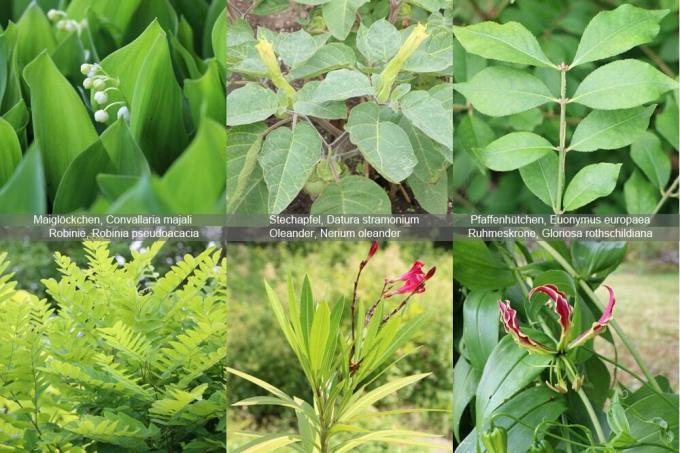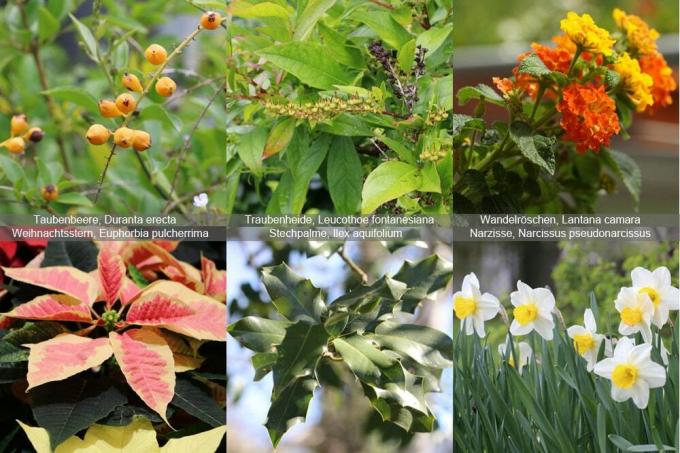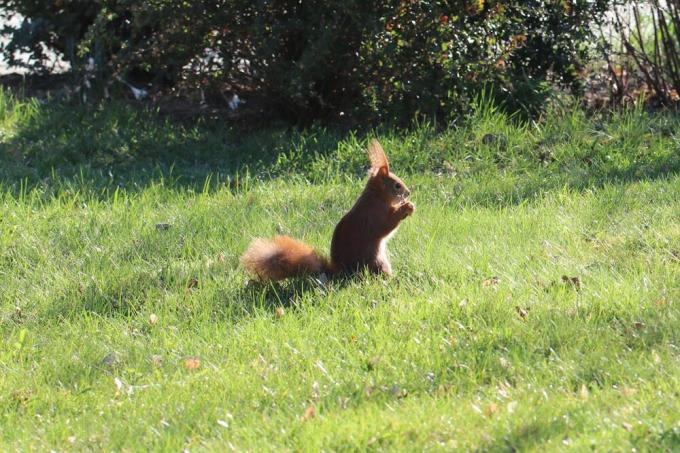

Table of contents
- PROFILE - Dangerous dog world
- Extreme caution - the really dangerous poisonous plants
- Poisonous Plants A-L
- Poisonous Plants M-S
- Poisonous Plants T-Z
- The Home Environment: Full of Canine Dangers
Dogs don't have much to do with plants, and they never have; the instincts to warn against poisonous plants didn't have to be particularly finely trained by wolves. Today's domestic dog has long since forgotten what used to be; wouldn't have done him any good with imported, poisonous exotics anyway. However, there are many imported, poisonous exotic species, so our pet dogs are constantly dealing with poisonous plants around them. The most poisonous of these should definitely be known to the mistress/master (and removed from the immediate domestic environment), the most dangerous poisonous plants for dogs are presented below:
PROFILE - Dangerous dog world
- Today's dog probably doesn't even recognize the most dangerous native poisonous plants
- As a carnivore, it is in any case incapable of recognizing poisonous plants
- The few instincts that exist have not been improved by a few thousand years of dog breeding
- Rather, epigenetic manipulation has rendered city dogs even more incapable of classifying poisonous plants
- Today's dog also has to deal with quantities of ornamental plants imported from far away
- Much of which is toxic to dogs
- That's why dogs who always have to put everything in their mouths live dangerously in today's world
- Even underemployed old dogs like to nibble around, in case of doubt about the "defenseless plant"
- In order not to let nibbling become a whim, domestic dogs should be kept busy (utilised).
Extreme caution - the really dangerous poisonous plants
Dogs are not genetically "engineered" to be herbivores; if a wolf really stuffed its stomach with (over)ripe apples, that was more of a thing Kind of dessert (+ probably with subsequent "spontaneous emptying" equal to a thorough one colon cleansing). The intended main food is the prey animal, and its (first of all devoured) stomach contents were the main plant material that reached the free-living forefather wolf. Pre-digested and thus digested in the food components wolf-friendly, with regard to toxic substances, the hunted prey also acts as a "pre-taster".
The genus Canideae (dogs) probably didn't develop any really great instincts towards plant toxins. Of these, the Canis lupus familiaris (domestic dog) has forgotten 90% in around 40,000 years of living with humans; many breeds of dog breeding, which has been practiced for thousands of years, have degenerated to such an extent that their fellow breeds can just sniff out their chap... Since the end of the 18th century, Since the beginning of the 20th century, more and more ornamental plants from foreign continents are being placed in front of our dogs in "their homes" - it is actually no great wonder that the poisonings are numerous and the list of poisonous plants dangerous for dogs is impressively long is.
So that your attention can stay with the one feature "terribly poisonous, absolutely avoid with a dog", all the bad poisonous plants are listed alphabetically. Regardless of whether these plants are statistically more likely to grow in the garden, in tubs on the patio, or in pots indoors can be found - some plants can appear anywhere or migrate from indoors to with the season outside.
Poisonous Plants A-L

- Bracken fern, Pteridium aquilinum, highly poisonous
- Adonis, Adonis sp., highly poisonous
- Azalea, highly poisonous, 1-2 leaves can be deadly
- Belladonna lily, Amaryllis belladonna, highly poisonous
- Mountain laurel, Kalmia angustifolia, highly poisonous
- Broom broom, Cytisus scoparius, highly poisonous
- Bitter Almond, Prunus dulcis var. amara, highly poisonous
- Bittersweet, Solanum dulcamara, highly poisonous
- Boxwood, Buxus sempervivens, highly poisonous
- Buckwheat, Fagopyrum esculentum, young flowers + seed coats are highly poisonous
- Christmas rose, Helleborus niger, highly poisonous
- Dieffenbachia, Dieffenbachia senguine, highly poisonous
- Yew, Taxus baccata, highly poisonous, 30 g needles/animal are lethal
- Monkshood, Aconitum sp, !most poisonous plant in Europe!
- Angel's trumpet, Brugmansia sp., is one of our most poisonous plants (wild form: thorn apple)
- Foxglove, Digitalis sp., highly poisonous, death after 5 g of dry leaves
- Germer, Weißer, Veratrum album, highly toxic
- Bell henbane, Scopolia carniolica, highly poisonous
- Gold lacquer, Erysimum cheiri, highly poisonous
- Laburnum, Laburnum anagyroides, highly toxic
- Autumn crocus, Colchicum autumnale, highly toxic, severe diarrhea from 0.25 mg/kg body weight, death from 1 mg/kg body weight
- Heavenly blossom, Duranta erecta, highly poisonous
- Dog poison, Apocynum sp., highly poisonous, see Oleander
- Dog parsley, Aethusa cynapium, highly poisonous
- Cacao tree, Theobroma cacao, highly poisonous
- Cherry laurel, Prunus laurocerasus, highly toxic, contains hydrocyanic acid, lethal amount 1-4 mg/kg body weight
- Croton, Codiaeum variegatum, highly poisonous
- Lavender heather, Pieris sp., highly poisonous, 1-2 leaves can be fatal
- Arborvitae, Thuja sp., highly poisonous
- Flax, Linum usitatissmum, highly poisonous
- Laurel roses, Kalmia sp., highly poisonous, 1-2 leaves can be fatal
Poisonous Plants M-S

- Lily of the valley, Convallaria majalis, highly poisonous
- Poppy, dormouse, Papaver somniferum, highly poisonous
- Nightshade, Solanum sp., highly poisonous
- Daffodil, Narcissus pseudonarcissus, highly poisonous
- Hellebore, Greens, Helleborus viridis, highly poisonous
- Oleander, Nerium oleander, highly poisonous, 0.005% body weight of dried leaves can be fatal
- Spindle tree, Euonymus europaea, highly poisonous
- Magnificent lily, Gloriosa superba, highly poisonous
- Rhododendron, Rhododendron sp., highly poisonous, 1-2 leaves can be fatal
- Larkspur, Delphinium sp., highly poisonous
- Castor bean, Ricinus communis, highly poisonous, is one of our most poisonous plants, a few castor seeds are sufficient as a lethal dose
- Black locust, Robinia pseudoacacia, highly poisonous
- Crown of Glory, Gloriosa rothschildiana, highly poisonous
- Sade tree, Juniperus sabina, highly poisonous
- Shadowbells, Pieris sp., highly poisonous, 1-2 leaves can be fatal
- Schellenbaum, Thevetia peruviana, highly poisonous
- Hemlock, spotted, Conium maculatum, highly poisonous, is one of the most poisonous plants
- Greater celandine, Chelidonium majus, highly poisonous, death after 60-120 g leaf juice
- Mezereon, Daphne mezereum, highly poisonous, one of our most poisonous plants, death after 12 g of bark
- Thorn apple, Datura stramonium, highly poisonous, is one of our most poisonous plants
- Holly, Ilex aquifolium, highly poisonous
- Stinky juniper, Juniperus sabina, highly poisonous
Poisonous Plants T-Z

- Pigeonberry, Duranta erecta, highly poisonous
- Deadly nightshade, Atropa bella-donna, highly poisonous, is one of our most poisonous plants
- Deadwort, Scopolia carniolica, highly poisonous
- Grape heather, Leucothoe fontanesiana, highly poisonous, 1-2 leaves can be deadly
- Tropical oleander, Thevetia peruviana, highly poisonous
- Lantana, Lantana camara, highly poisonous
- Water hemlock, Cicuta virosa, highly poisonous, is one of our most poisonous plants
- Poinsettia, Euphorbia pulcherrima, highly poisonous, the existing non-poisonous varieties cannot be distinguished from the toxic ones
- Grapevine, Vitis vinifera spp. sativa, highly toxic in all parts of the plant
- Spurge, Euphorbia sp., highly poisonous
- Miracle tree, Ricinus communis, highly poisonous, is one of our most poisonous plants, a few castor seeds are sufficient as a lethal dose
- Miracle shrub, Codiaeum variegatum, highly poisonous
- Male fern, Dryopteris filix-mas, highly poisonous
- Desert rose, Adenium obesum, highly poisonous
- Bryonia sp., highly poisonous
- Ornamental paprika, Capsicum annuum, whole plant highly poisonous, fruits contain only a few alkaloids
Notice
Preventive information to avoid accidents is best remembered if it is obtained in advance (without pressure, in the case of "Dogs and poisonous plants" i.e. before the most endangered and most sensitive young dog in the house is). Deal carefully and thoroughly with the poisonous plants that can be dangerous for your (future) dog, refresh your knowledge later from time to time. Find the most toxic plants in your area, ask your vet how poisoning would be treated with them, write down the telephone number of the nearest poison control center on your smartphone and on a piece of paper on the fridge/inside Wallet. List of poison control centers: www.bvl.bund.de/DE/01_Lebensmittel/03_Verwachsener/09_fectionsIntoxikationen/02_Giftnotrufzentralen/lm_LMVergiftung_giftnotrufzentralen_node.html.
The Home Environment: Full of Canine Dangers

Among the garden and houseplants there are plenty more plants that won't kill a leaf-munching dog, but from diarrhea to muscle twitching, weakness and anemia in the dog's body cause all sorts of (temporary) disturbances can.
Even the dog that eats grass as a normal way to cleanse the colon can be unlucky when the grasses become infested with fungi that produce toxins.
However, the probabilities here are in the range of individual percentages, with one of many different grasses in the lawn - the grass fungi are only mentioned here because so that something else should be brought into their field of vision: Today's plant world with all its wonders of modernity (exotic imports, development of fungi promoting monocultures, artificial fertiliser) is as foreign to your dog's organism as the contents of his grooming cupboard (with all the wonders of the modern chemistry).
Foreign to the organism means: incompatible to toxic. Once a dog living in today's world shows symptoms ranging from limping after frolicking while romping or vomiting after eating the buffet stolen holiday roast or even appear without a cause, you should briefly discuss the possibility of poisoning ponder.
That was the dangerous world outside, but in the closest environment (pack cave / apartment / house) there are also a few dangers lurking for dogs that not every mistress/master is sufficiently aware of.
Many dogs like to cook with you, in the sense that the floor is immediately and thoroughly cleaned of any leftover food that falls off when cutting. Purification occurs through consumption, and some dog owners really do drop a few dog treats every time such a dog owner cooks “together” with a dog, whose If the taste was not reduced to "pure beef tartare" or "Premium Reinina" when it was young, this dog should never get the following things in front of its muzzle: avocados (gastrointestinal symptoms + pancreatitis), yeast dough / raw sourdough (alcohol poisoning, for a 4 kg dog, 250 g of dough is sufficient), garlic and onions (cooked in larger quantities, cause, among other things, a special form of Anemia).
Many dogs are also happy to join in the snacking in front of the TV, here the strictest ban applies to macadamia nuts (poisonous, reason unknown, complaints usually appear after 48 hours). over), the raisins from the trail mix (highly toxic for an unknown reason, kidney failure possible from 2.6 g per kg body weight); and a piece of chocolate is just as forbidden as the grapes from the fruit plate (dogs die from cocoa theobromine from 250 mg per kg body weight = 62.5 g or a few pieces of 70% chocolate for the 5 kg small dog, grapes s. above raisins, kidney failure possible from 10 g per kg body weight).
If you want to keep up with the latest trends in the food market (food substitutes market). are there, double caution is required: For example, it is already in many sweets and chewing gum Etc. The sweetener xylitol it contains is toxic to dogs and has recently also been offered as a sugar substitute for baking; Decontamination is recommended from 50 mg xylitol/kg body weight, which is quickly achieved if a dog gets baked goods made with xylitol between its claws.
Tip:
If you want to avoid accidents, you need imagination, especially with regard to what can lead to an accident happening. For Poison and Poisoning this means that it is best to get in the habit of checking all products in packages with lists of ingredients for toxic ingredients. If your dog steals some horn shavings from the farrier, he can enjoy these "dog chips"; if he steals them from your pack of horn shavings for the garden, he might perform his poisonous miracle if you have not read that castor meal was added to the horn shavings (with ricin, see above, castor, Wondertree).
 garden editorial
garden editorial I write about everything that interests me in my garden.
Learn more about beneficial insects

What does hedgehog droppings look like? | Recognize hedgehog droppings
Hedgehogs are not only very cute, but also useful animals. a. devour the unpopular slugs in the garden. They feel particularly comfortable in natural gardens. Their legacies, which can even be hazardous to health, are less pleasant.

What does raccoon droppings look like? How to recognize him
Raccoons are purely outwardly, quite cute contemporaries. However, this does not hide the fact that these are wild animals that can cause great damage in the garden and on the house. This masked intruder can pose a danger to residents and pets.

Recognizing squirrel droppings: typical appearance with picture
Gardens provide an oasis for many wild animals to forage there. The animal visitors leave clearly visible traces in the form of droppings. If you take a closer look at the pieces of excrement, you can see which animal was the cause based on certain clues.

Recognizing fox droppings: 5 characteristics with a picture of the fox droppings
If animal droppings are found in the garden, it is annoying in any case. However, there can also be a danger with fox droppings in particular. But how can fox droppings be recognized and what should be considered when removing it?

drive away wild bees | What to do against wild bees in the garden?
If you want to drive away and get rid of wild bees, you should use natural and gentle means. Because the insects are useful in the garden and generally important for the environment. In addition, they are rarely threatening. We reveal how the fight works.

List: these ant species exist in Germany - ants
Ants can be found everywhere, whether in the forest, on a roadside, in the garden or even on the terrace and in the house if there is something interesting for the animals. But not all ants are the same, there are over 13,000 species of ants worldwide, 200 of them in Europe alone.

